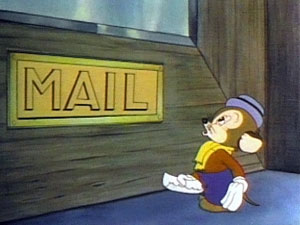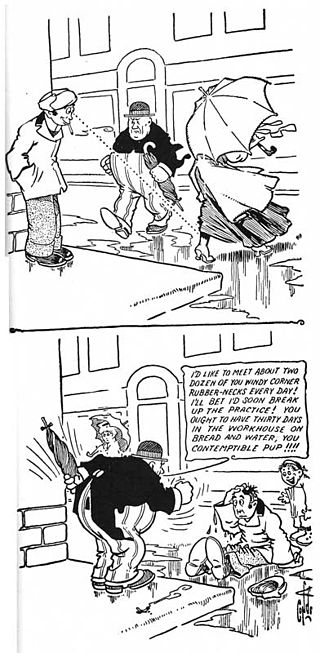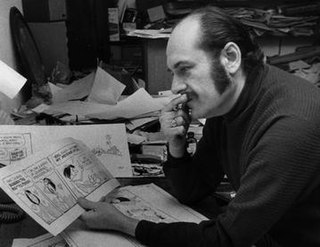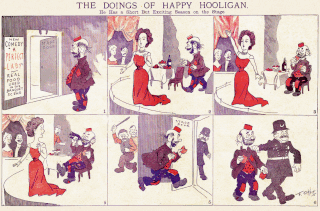
The Katzenjammer Kids is an American comic strip created by Rudolph Dirks in 1897 and later drawn by Harold Knerr for 35 years. It debuted on December 12, 1897, in the American Humorist, the Sunday supplement of William Randolph Hearst's New York Journal. The comic strip was turned into a stage play in 1903. It inspired several animated cartoons and was one of 20 strips included in the Comic Strip Classics series of U.S. commemorative postage stamps.

The Little Bears is an American comic strip created by Jimmy Swinnerton, one of the first American comic strips featuring talking animals and one of the first with recurring characters – the titular bears. The feature emerged from a series of spot illustrations of a bear cub that began appearing in The San Francisco Examiner starting October 14, 1893. The strip was launched as a regular feature on the children's page starting June 2, 1895, and ran through June 7, 1897.

Sniffles is an animated cartoon and comic-book mouse character in the Warner Bros. Merrie Melodies and Looney Tunes series of cartoons and comics.

Henry is a comic strip created in 1932 by Carl Thomas Anderson. The title character is a young bald boy who is mostly mute in the comics. Except in a few early episodes, when the comic strip character communicates, he does so largely but not entirely through pantomime. He also spoke in a comic book series of 1946–1961 and in at least one Betty Boop cartoon from 1935 in which Betty Boop has a pet shop and Henry speaks to a dog in the window.

Harvey Comics was an American comic book publisher, founded in New York City by Alfred Harvey in 1941, after buying out the small publisher Brookwood Publications. His brothers, Robert B. and Leon Harvey, joined shortly after. The company soon got into licensed characters, which, by the 1950s, became the bulk of their output. The artist Warren Kremer was closely associated with the publisher.
Don Markstein's Toonopedia is an online encyclopedia of print cartoons, comic strips and animation, initiated February 13, 2001. Donald D. Markstein, the sole writer and editor of Toonopedia, termed it "the world's first hypertext encyclopedia of toons" and stated, "The basic idea is to cover the entire spectrum of American cartoonery."

The Outbursts of Everett True was an American two-panel newspaper comic strip created by A. D. Condo and J. W. Raper that ran from July 22, 1905 to January 13, 1927, when Condo had to abandon it for health reasons.

James Guilford Swinnerton was an American cartoonist and a landscape painter of the Southwest deserts. He was known as Jimmy to some and Swinny to others. He signed some of his early cartoons Swin, and on one ephemeral comic strip he used Guilford as his signature. Experimenting with narrative continuity, he played a key role in developing the comic strip at the end of the 19th century.

Harry Conway "Bud" Fisher was an American cartoonist who created Mutt and Jeff, the first successful daily comic strip in the United States.

Howard "Howie" Post was an American animator, cartoonist, and comic strip and comic book writer-artist.

Gene Carr was an American cartoonist.

Bronc Peeler was a Western adventure cowboy comic strip created by Fred Harman in 1933, and ran until July 2, 1938. Harman is best known as the artist for the Red Ryder comic strip, which he created with Stephen Slesinger.

Little Jimmy, originally titled Jimmy, is a newspaper comic strip created by Jimmy Swinnerton. With a publication history from February 14, 1904, to April 27, 1958, it was one of the first continuing features and one of the longest running.

Happy Hooligan is an American comic strip, the first major strip by the already celebrated cartoonist Frederick Burr Opper. It debuted with a Sunday strip on March 11, 1900 in the William Randolph Hearst newspapers, and was one of the first popular comics with King Features Syndicate. The strip ran for three decades, ending on August 14, 1932.

Little Hiawatha is a 1937 animated cartoon produced by Walt Disney Productions, inspired by the poem The Song of Hiawatha by Henry Wadsworth Longfellow. It does not appear to have historical correlation to legendary Mohawk leader and peacemaker Hiawatha. It is the last Silly Symphonies short to be released by United Artists.
This is a timeline of significant events in comics in the 1910s.
This is a timeline of significant events in comics in the 1900s.

Harold Hering Knerr was an American comic strip creator, who signed his work H. H. Knerr. He was the writer-artist of the comic strip The Katzenjammer Kids for 35 years.
Jerry on the Job is a comic strip created by cartoonist Walter Hoban, set for much of its run in a railroad station. Syndicated by William Randolph Hearst's International Feature Service, it originally ran from 1913 to 1931. The strip had a brief revival by Bob Naylor from 1946 to 1949.
The New York World was one of the first newspapers to publish comic strips, starting around 1890, and contributed greatly to the development of the American comic strip. Notable strips that originated with the World included Richard F. Outcault's Hogan's Alley, Rudolph Dirks' The Captain and the Kids, Denys Wortman's Everyday Movies, Fritzi Ritz, Gus Mager's Hawkshaw the Detective, Victor Forsythe's Joe Jinks, and Robert Moore Brinkerhoff's Little Mary Mixup.















